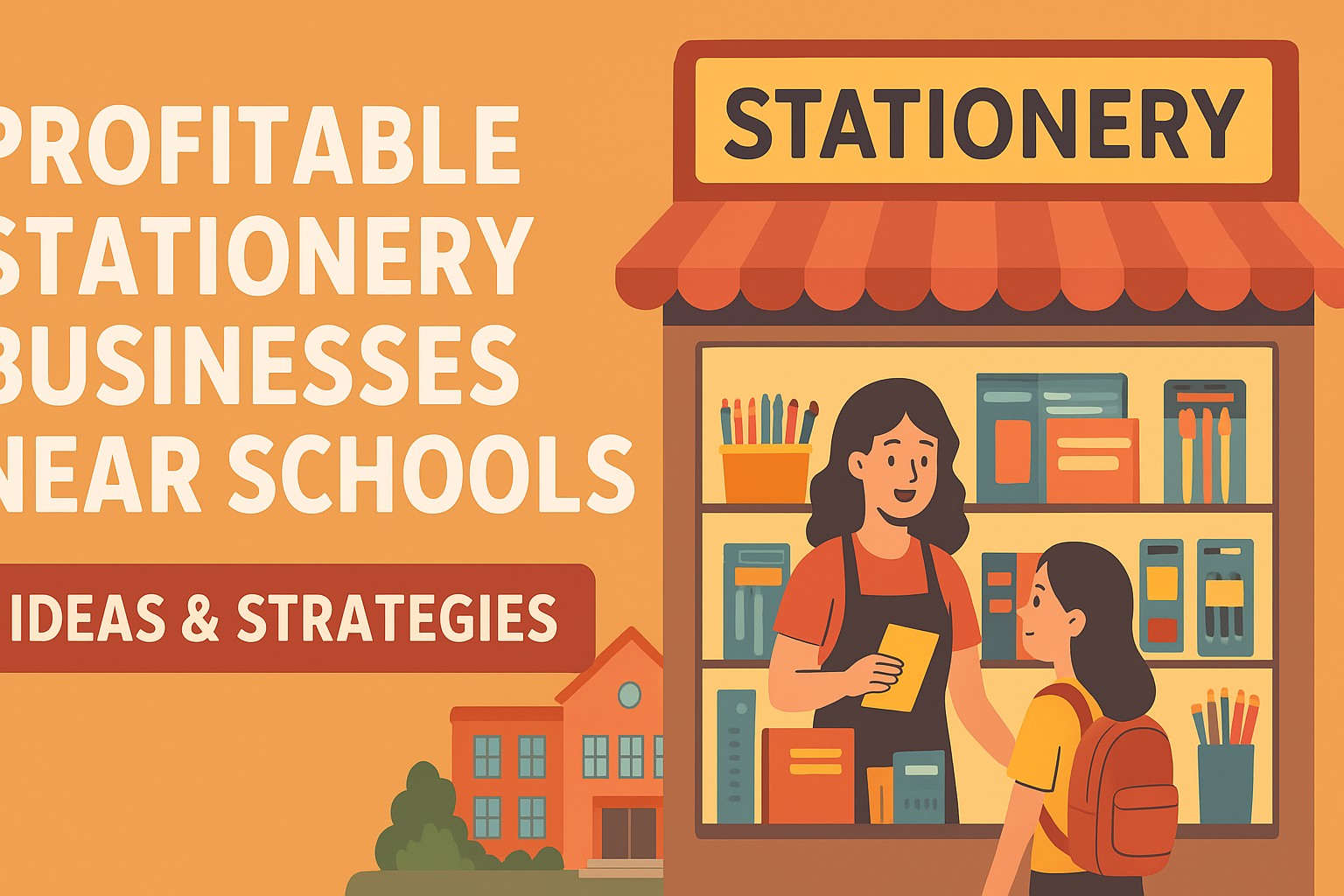

Titus Morebu
Author
Profitable Stationery Businesses Near Schools: Ideas & Strategies
Discover proven stationery business models tailored for school zones — from retail kiosks to customized kits. Learn how to maximize profit, marketing & operations.
Why Schools Are Prime Locations for Stationery Businesses 🎯
Schools generate consistent demand for pens, notebooks, art supplies, and accessories. Students, teachers, and parents all need stationery — making areas near schools a natural catchment for profitable ventures. With smart positioning, the right model, and strong marketing, a stationery business near schools can become a dependable revenue stream.
What Makes a Stationery Business Near Schools Profitable?
- High foot traffic & repeat customers: Daily drop-ins from students and teacher replenishment orders.
- Seasonal bursts: Back-to-school periods generate concentrated demand spikes.
- Low-cost consumables: Items like pens, pencils, erasers, notebooks – inexpensive to stock and fast-moving.
- Value-added services: Custom printing, bundling, repair/refill services (e.g. fountain pen, art supplies) raise margins.
- Impulse buys: Small trendy items (stickers, washi tape, decorative pen sets) often purchased on a whim.
Business Models to Try Near Schools
1. Mini Kiosks / Pop-Up Stalls
Set up small kiosks or carts just outside school premises. Low overhead, great visibility, and accessible to students before/after classes.
- Offer basic essentials (pens, pencils, sharpeners, erasers).
- Have display racks for colorful items and small gifts.
- Rotate stock quickly to match trending demands (e.g. themed stationery, seasonal items).
2. Full-Service Stationery Shops
A brick-and-mortar store near schools that offers a wide range—basic supplies, art materials, notebooks, planners, custom printing, lamination, binding, and even gift items.
- Stock premium and niche products (sketchbooks, specialty paper, designer pens).
- Offer school uniform or merchandise tie-ins (notebooks with school crest, branded rulers).
- Partner with schools to supply bulk kits or branded stationery to students.
3. Bundled School Kits & Subscription Packs
Create “back-to-school kits” or monthly subscription boxes delivered to students. Bundles might include pens, notebooks, rulers, erasers, and extras.
- Offer school-specific kits (grade level, subject, or elective combinations).
- Use subscription or preorder models to manage inventory and cashflow.
- Promote kits through parent-teacher associations, school newsletters, and online marketing.
4. On-Campus Delivery & Wholesale Partnerships
Instead of or in addition to storefronts, offer delivery or bulk sales to school bookstores, teachers, or administration. You act as a supplier for internal needs.
- Negotiate contracts for supply of pens, paper, exam pads, teacher planning books.
- Offer discounts for regular bulk orders.
- Provide convenience: fast restocking or scheduled delivery days.
Estimating Margins & Costs 📊
Typical stationery businesses may achieve gross profit margins of 45-55%, and net margins after expenses around 5-15%. Basic supplies tend to have lower margins, while custom, premium, or designer items command higher markups.
Key cost components to watch:
- Rent, utilities, staffing
- Packaging, logistics, transport
- Marketing, POS systems, inventory management
- Seasonal fluctuations and unsold inventory risks
Key Strategies to Boost Profit & Stand Out
Curate a Distinctive Product Mix
Offer a balance between everyday items and specialty/novelty ones. Unique products, limited editions, or niche art supplies can command higher margins.
Leverage Customization & Personalization
Provide services like name embossing, custom planners, branded stationery, event invites. These services create differentiation and enhance customer loyalty.
Bundle & Upsell
Group complementary items into kits or packs (e.g. notebook + pen + sticky notes). This boosts average transaction value. Upsell protective cases, decorative covers, or premium pens at checkout.
Use Digital Marketing & Local SEO
Get your shop on Google Maps, optimize for keywords like “stationery shop near me,” “school supplies in [your area].” Use social media (Instagram, TikTok) to showcase creative products. Collaborate with parent groups and school social media for exposure.
Offer Loyalty & Referral Programs
Reward repeat customers with discounts or points. Encourage students or teachers to refer others in exchange for freebies. This drives word-of-mouth growth.
Seasonal & Trend Planning
Align stock and promotions to seasonal periods—back to school, exam seasons, graduation, holidays. Monitor trends (eco-friendly materials, designer stationery) and refresh product lines regularly.
Challenges & Mitigation
- Inventory risk: avoid overstock by using preorder or just-in-time restocking.
- Competition: big retail chains or online platforms may offer lower prices — compete on convenience, niche products, or value-added services.
- Cash flow variability: seasonal sales may fluctuate — build reserves and manage credit carefully.
- Permit and licensing: ensure you comply with local business regulations, taxation, and licensing.
Case Stories That Inspire
Some stationery businesses have scaled impressively purely through online channels, growing to 7-figure revenues by focusing on unique designs and strong brand appeal. Beginning from small print orders and gradually reinvesting profits into expansion proves that even with modest startup budgets, scaling is possible.
Closer to school environments, many successful small shops base their growth on winning contracts to supply student kits or leveraging campus relationships for sustained demand.
Checklist for Launching a Stationery Venture Near Schools ✅
- Conduct location & demand survey around target schools.
- Define your niche and target audience (students, teachers, parents).
- Prepare a business plan with cost forecasts and margin analysis.
- Secure a location or permit for kiosk/shop; set up necessary licenses.
- Source reliable suppliers, consider wholesale and drop-ship partnerships.
- Design your product mix, kits, and services (customization, bundles).
- Set up POS, inventory system, and digital presence (website, maps listing).
- Launch with a marketing push (back to school campaigns, open day discounts).
- Collect feedback, adjust product lines, monitor margins and cash flow.
- Establish B2B channels with schools and bulk buyers.
Final Thoughts
A well-executed stationery business near schools taps into consistent, captive demand. With the right niche, operational efficiency, and marketing, you can build a sustainable, profitable venture. Focus on value, relationships, and adaptability — and let your brand become the go-to for students, teachers, and parents alike. 🚀
Gallery

Related Articles
3 articles
Electrical & Internet Installation Business in Kenya: How to Launch & Succeed 💡
Build a profitable electrical + internet installation business in Kenya: from market analysis, service mix, licensing, operations, marketing, to scaling for sustainable growth.

How to Sell Fresh Juice & Snacks in Residential Estates – Ultimate Guide
Discover how to launch and grow a thriving fresh-juice and snack business in estates: location, menu, pricing, marketing & logistics all covered.

How to Earn Money with Affiliate Marketing in Kenya: Your 2025-Ready Roadmap 💡
Learn how to make money through affiliate marketing in Kenya by choosing the right niche, joining solid programs, driving traffic, and getting paid—all step by step.